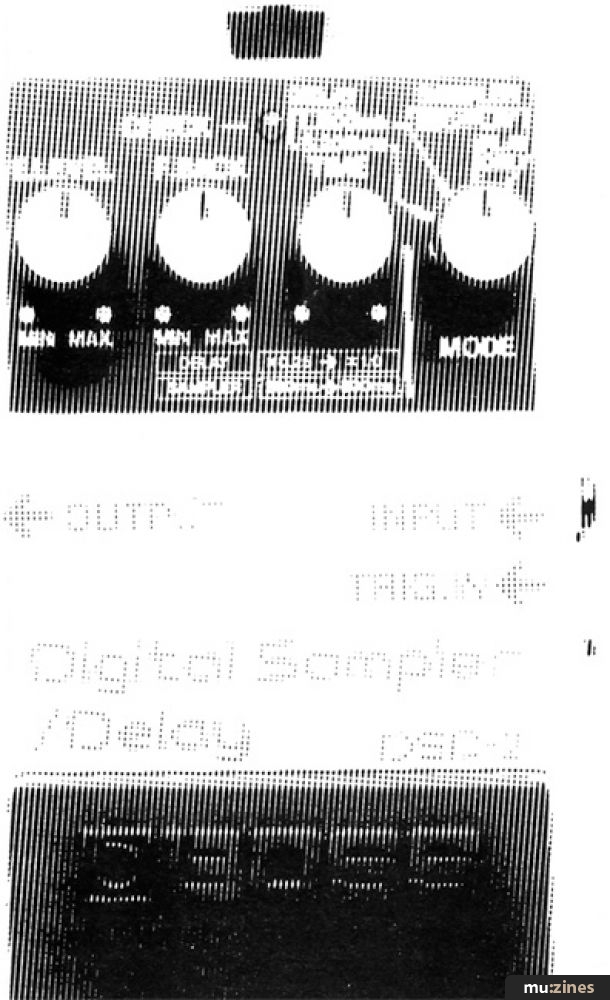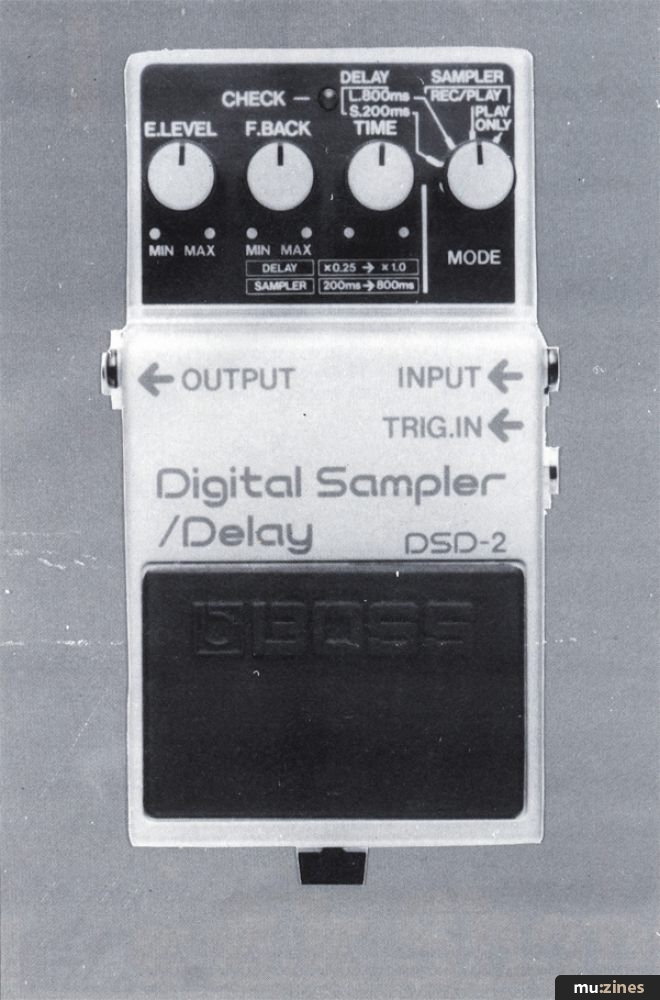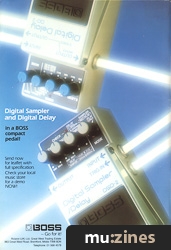Magazine Archive
Home -> Magazines -> Issues -> Articles in this issue -> View
Boss DSD2 | |
Article from Electronics & Music Maker, October 1985 | |
A modest newcomer to the sampling arena is Boss' DSD2 pedal. Paul White finds out if it's capable of more intelligent iterations than 'hangover'.
It may not quite be a Fairlight in a pedal, but at exactly £200, Boss' new DSD2 delay unit is the closest thing to free sampling we're likely to see for a while.

Apart from its highish price, the Fairlight CMI has one major disadvantage: it's too big. People with beautifully restored Tudor castles or Georgian mansions have no difficulty in dedicating entire hallways to the Computer Musical Instrument, but in the average suburban semi, housing such a £30,000 wonder-machine can be a problem. Luckily, the Boss wing of the Roland Corporation have come up with what is essentially a similar device, except that it is housed in a footpedal case that looks from the outside like all the other Boss pedals. But poetic licence must end somewhere, so I might as well say right now that, truth to tell, the new Boss DSD2 is more or less a pedal version of the company's well-established DE200 rack-mounted sampling delay unit. The pedal lacks the rack box's modulation facilities, and as with the DE200, there's no way you can control the pitch of the stored sound in a musically meaningful way: all you can do is change the pitch by using the delay time control (well, I suppose it could be musical). Still, there are plenty of wondrous things you can do with the DSD2 if you go out and buy one, make sure you look at the manual, and read this review before you do either.
As Boss fans will know already, all the company's pedals feature FET switching for quiet operation, and the battery is located beneath the pedal for ease of changing. I reckon it would be worth using a mains adaptor whenever possible with this particular pedal, though, as digital circuitry of this kind eats up batteries faster than a Sinclair C5 (though with much more useful results).
There are only four knobs and one LED on the pedal (which is just as well, as there isn't room for much else), so operation is very straightforward. First comes the E.Level control, which you use to adjust the balance between the dry and delayed components of the signal. F.Back (yes, you've guessed) is the feedback control, which sets up the length of time the echoes take to die away. With this control at maximum, the delay line can be made to oscillate. Delay Time... now that's a tough one: it gives continuous control between minimum and maximum delay time and works in conjunction with the Mode control, which isn't actually a pot at all but a four-position switch. Its first two positions select 200mS or 800mS maximum delay time respectively. The third position is designated Rec/Play, and allows new sounds to be recorded as old ones are replayed - this makes it suitable for rhythm sync effects. In this mode, the stored sound is retriggered either by supplying a trigger pulse or by pressing the pedal when a new sound is recorded. If a single burst of sound is recorded in this way, the mode can then be switched to play only, so that you can trigger the stored sound by pulse or pedal without fear of erasing it accidentally. Employ a high level of feedback when you sample a sound, and you can layer subsequent sounds over the first if the mood takes you. And should you hold the pedal down continuously when the unit is in Play mode, the stored sound is looped continuously until you release the pedal - logical and eminently useful.
No battery backup is provided, so any stored sounds are lost as soon as the power disappears (this happens as soon as you remove the output jack). Last and by every means least is the LED; this tells you if the delay is active or bypassed - and if the battery is past its best.
That just about wraps up the DSD2's controls and what they do. How do you put them to use? Well, if you know what you're doing (and it isn't complicated), you can coax the pedal into doing all kinds of things.
First off, straight echo. The DSD2 gives up to 800mS of delay, and its 7kHz bandwidth means that the sound quality is respectably bright, even if it isn't up to the standard of an expensive rack-mount unit. But there are two more modes of operation that could be of great interest both live and in the studio; these are Rhythm Sync and, as befits the pedal's title (DSD stands for 'digital sampling delay'), Sampling.
Rhythm Sync is what you get when you use the pedal in its Rec/Play mode and synchronise the echoes to an external trigger pulse, in this case connected via an additional jack socket on the side of the pedal.

In Sampling mode, you can trigger a short burst of sound stored in the unit's memory, again using an external trigger pulse of some kind. Look no further than the Trigger Outs on a drum machine for a typical source of such a pulse.
"Performance - As a straight echo machine, the DSD2 produces a cleaner, brighter sound than its bandwidth would lead you to expect."
As a sampler, the DSD2 is also at its most impressive when driven from a drum machine, as the standard percussive sounds may then be replaced or supplemented by a sound of your own choosing. Not only can you store the sound of a crate of Newcastle Brown falling off the back of a lorry, you can also change its pitch up or down by varying the setting of the delay time control. And don't forget that the position of said control when the sound is recorded also has an effect on the stored pitch.
Rhythm sync is particularly effective if you use a drum machine with a programmable trigger output, as you can program the echoes to occur on whichever beats you choose. Lots of contemporary rhythmic sounds can be set up in this way, with guitar and bass sounding very impressive under test.
As a straight echo machine the DSD2 does a fine job, producing a brighter, cleaner sound than its bandwidth would lead you to expect, and with a very low level of background noise. In this respect, the new device is very similar to Boss' excellent DD2 delay pedal, but the triggered options add greatly to the flexibility of the DSD2.
The only tricky thing about using this kind of unit to sample a sound is timing. You have to press the pedal or supply the trigger pulse at exactly the right moment if you're going to stand a chance of capturing the whole sound, from the beginning, without chopping anything off or recording any dead time.
With a bit of practice, you can train your right foot into reacting in the correct way at the correct time, but luckily for readers of this esteemed publication, this correspondent has succeeded in sidestepping the problem altogether by designing a simple sound trigger circuit. For further details of this, turn to the November '84 edition of that other esteemed publication, Home Studio Recording.
Rhythm sync is one of those things that you really have to try for yourself before you realise how useful it can be, but the benefits of sampling are more obvious. All the common Paul Hardcastle effects are easily produced, and you can just about store two complete words (if they're short enough) in the 800mS sampling time. The possibility of adding the sound of breaking bottles to a drum machine is quite appealing (or should that have read 'appalling'?), and it's always a source of constant wonderment when some hitherto mundane kitchen utensil turns out to give a really amazing drum sound.
Cheap and (triggering problem aside) easy to use, the DSD2 is the most innovative FX pedal I've seen for a long time. It puts sampling within reach of almost everybody, and adds a useful, decent-quality digital echo into the bargain. Next month: Boss put the workings of an entire Solid State Logic mixing desk into a 1U-high rack-mounting box...
DATAFILE - Boss DSD2 Sampling Delay Pedal
Controls E Level; Feedback; Delay Time; Mode
Interfacing Input & Output jacks; Trigger In jack
Dimensions 70(W) X 55(H) X 125(D)mm
Weight 450g (0.99lb)
RRP £200 including VAT
More from Roland UK, (Contact Details)
Also featuring gear in this article
Boss DSD-2
(12T Aug 85)
Boss DSD-2 Digital Sampler - Effectscheck
(IM Aug 85)
Pedal Power - Boss DSD2 Sampler/Delay
(HSR Nov 85)
Two Into One - DSD-2
(ES Aug 85)
Browse category: Guitar FX > Boss
Publisher: Electronics & Music Maker - Music Maker Publications (UK), Future Publishing.
The current copyright owner/s of this content may differ from the originally published copyright notice.
More details on copyright ownership...
Review by Paul White
Previous article in this issue:
Next article in this issue:
Help Support The Things You Love
mu:zines is the result of thousands of hours of effort, and will require many thousands more going forward to reach our goals of getting all this content online.
If you value this resource, you can support this project - it really helps!
Donations for April 2024
Issues donated this month: 0
New issues that have been donated or scanned for us this month.
Funds donated this month: £7.00
All donations and support are gratefully appreciated - thank you.
Magazines Needed - Can You Help?
Do you have any of these magazine issues?
If so, and you can donate, lend or scan them to help complete our archive, please get in touch via the Contribute page - thanks!









